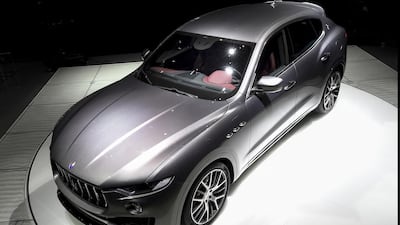The motoring landscape has changed beyond all recognition over the past decade, driven by customer demand for sports utility vehicles. This region has always had a love affair with them, for obvious reasons: there’s lots of space inside most of them for large families, and they’re better at going off-road than your average four-door saloon. But the insatiable hunger for SUVs has crept into every single market, and the ramifications are as huge as the cars themselves.
This week, I attended the regional unveiling of the Maserati Levante. The launch of this new model seems to have taken forever, but now it’s here, and its maker understandably has high hopes for it. After all, when you look at the success of models that previously looked like bad jokes – the Porsche Cayenne and the Bentley Bentayga spring to mind – the brands responsible for them have enjoyed immediate sales success. If it wasn’t for the Cayenne, Porsche might be struggling to survive right now.
There’s a level of pre-emptive-strike logic with SUVS – people thinking: “Other people have one, so I must have one, too, because if that Range Rover smacks into my otherwise capable and perfectly adequate car, I’m going to come off much worse. ”
But there’s much more to the SUV’s rise in popularity than personal protection. Now, practically every manufacturer is offering them in their ranges, with the new Maserati being the latest. We’re expecting them soon from Lamborghini and Rolls-Royce, too. Aston Martin has confirmed it’s to build its DBX crossover before the decade is out, and only Ferrari has gone on record to say: “No way, José.” But as previously noted in these pages, Porsche said that about diesel engines a decade ago, and now look at it.
For car companies to survive and prosper in these times, they need to adapt. Which is why in recent months Bentley has launched the aforementioned Bentayga, and Jaguar has begun rolling out its ridiculously named F-Pace – both cars that, had you spoken to their company representatives a short time ago, would have been dismissed as “never going to happen”. And with the Levante Maserati has, in some respects, drawn first blood.
Priced at less than Dh400,000, even for the range-topping S variant, it certainly makes a decent fist at the luxury angle, and the brand still enjoys an almost mythical status as being special and desirable, despite its increased annual production numbers. On the face of it, as it emerges from its enclosure in front of the press, surrounded by billowing clouds of dry ice, it could very well be the Italian company’s Cayenne. It certainly looks like one, at least in side profile.
My main issue with these new SUVs is that they all look the same and do basically the same thing. And if you’re looking at the photo of the Levante and thinking “hmm, it looks like a Cayenne that’s merged with an Infiniti, which has already been morphed with a BMW X5, an F-Pace and an Audi Q5”, there’s good reason for that. To attain the overall proportions required for an SUV, there’s no way to design anything actually beautiful or unique – the only options for individuality being the front and rear ends, and the interior. All of which, incidentally, Maserati has been successful with here. Take my word for it, the Levante looks much better in real life than in photographs, which in itself is a blessed relief.
How will it drive? If the snarling, angry exhaust note and the video projections showing the car drifting like a hooligan are anything to go by, it will be all kinds of fun. But even if it isn’t, we will soon see these vehicles everywhere in the UAE. The SUV isn’t going away anytime soon and neither, I’d venture to suggest, is Maserati.
motoring@thenational.ae
Follow us @LifeNationalUAE
Follow us on Facebook for discussions, entertainment, reviews, wellness and news.

